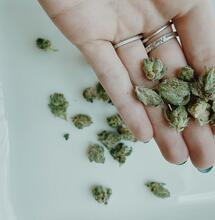How to Remedy a Sick Plant

You started with high hopes. Now, one of your plants looks a little bit worse for wear, and you are thinking, why is my plant dying? There are many reasons your cannabis plant might look a bit ill; here, we focus on the essential steps you can take to try and remedy any issues.
You started with high hopes. Now, one of your plants looks a little bit worse for wear, and you are thinking, why is my plant dying? There are many reasons your cannabis plant might look a bit ill; here, we focus on the essential steps you can take to try and remedy any issues.
Sick or stressed cannabis plants display lots of symptoms. Here are some primary signs that sick cannabis plants display and quick and simple ways to remedy them.
Yellow Leaves
Yellow leaves can appear for many reasons, such as nutrients, watering and lighting issues.
Overwatering
Novice growers can tend to look after their plants a little too much. They may water too much, suffocating roots and making them susceptible to root rot.
Underwatering
Underwatering mainly results from neglect when growers go on vacation or a heatwave strikes. Missing a few days of watering can enormously influence a plant's energy.
Nitrogen Deficiency
A lack of this crucial primary element when fertilising will result in nitrogen deficiency. This is recognisable by the yellowing of leaves that starts low down and gradually moves up the plant.
To remedy this, you must add more Nitrogen. Try a liquid seaweed foliar spray first, as this will get much-needed Nitrogen into your plants fast. There are plenty of sources to choose from.
Nutrient Burn
Nutrient burn is caused by overfeeding when growers mix their nutrients stronger than recommended. Whilst too few nutrients can cause deficiencies, too much use can create a toxic environment. You will recognise this on your plants by emerging dark-green leaves with yellow and brown tips.
To fix nutrient burn, flush your soil with clean, pH-balanced water and restrict nutrients until the symptoms resolve, forcing your plants to use any excess. Then, you'll need to reevaluate your feeding schedule. Follow the product instructions accurately to avoid repeating the same mistake. If they got you into this mess, start by halving the recommended values.
Stretching
Stretching can cause cannabis plants to become weak and risk toppling over. While some strains stretch more than others naturally, this symptom mainly originates from environmental factors. Suppose your seedlings are becoming too "leggy" or your vegging plants are starting to stretch excessively. In that case, chances are you need to reposition your lights.
A lack of light exposure causes your plants to reach out toward any available light in sheer desperation.
Excessive temperatures can also cause seedlings to become too skinny. Place a hygrometer in your grow room to measure temperature and humidity. Aim for between 19–20°C during the day and 13°C overnight.
Stunted Growth
Several variables can cause it. Stunted growth can make plants appear weak and lower yields. They may also show signs of nutrient deficiency.
Lack of nutrients- You'll also see other signs of nutrient deficiencies. Apply regular doses of a fertiliser boost product and add mycorrhizae to your medium as a root drench.
Calcium deficiency- This deficiency is a cause of stunted growth. There will also be discoloured young shoots and curled new development. Try a Cal-Mag (calcium/magnesium) supplement to remedy things.
Lack of Light- You need a light cycle of 18 hours on and 6 hours off during Veg. Use a timer to keep things accurate.
Transplant stress- Minimise the number of transplants you perform during your growing cycle. If your seedlings are healthy, you can transfer them to much bigger roomier pots to avoid unnecessary transplants.
Underdeveloped Buds
Popcorn buds, as they are known, are those small, airy, underdeveloped flowers. Avoid and reverse the chances of popcorn buds by Defoliating your flowers to increase exposure to light and air. Keep your plants well-fed with high levels of phosphorus and potassium designed explicitly for the flowering stage. Buds overshadowed by a dense canopy will not perform well.
Leaves Turning Upward
Some refer to this condition as "canoeing". This can be caused by too hot or too cold conditions, causing your leaves to grow slowly. Target temps are 22–28°C during Veg and 20–26°C during flowering.
White Powdery Patches
White powdery patches on the fan and sugar leaves indicate the presence of powdery mildew. This fungal disease damages plants in the later stages of infestation. Symptoms include stunted growth, deformed leaves, and infection of newly formed tissues. To beat this mould before it gets out of hand, try wiping leaves with a wet paper towel and apply a neem foliar spray. An excellent DIY remedy is to mix 1 tbsp of baking soda into 4 litres of water and spray it onto foliage.



.png)







